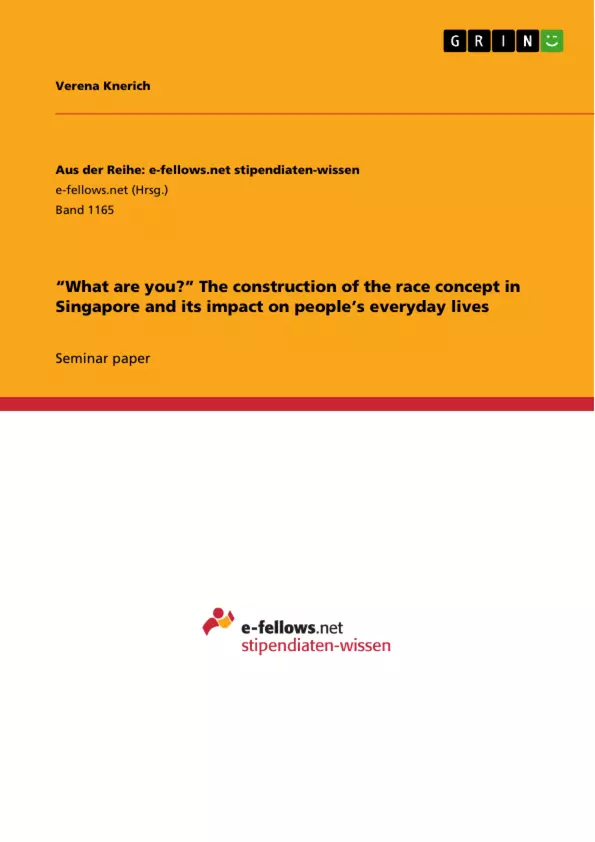“Race” seems to be an omnipresent feature of society, public discourse and identity formation in Singapore. To offer a brief insight into how this important concept came to be and which impact it has on society and everyday life, shall be the objective of this paper.
As the People’s Action Party has been in power since 1959 and its politics have unquestionably shaped this country immensely, the PAP’s influence will be discussed in the first chapter. After offering an overview of the historic circumstances that moulded the party’s ideology of multiracialism and hence race itself, more concrete measures of creating the CMIO categories will be presented.The second part of this paper is dedicated to analyzing the consequences of these policies on public discourse. Firstly I shall discuss how identity is categorized by race and how the perception of the “Other” is shaped accordingly. Finally I will shortly present how the race concept can be interpreted as an essentialization of the main racial traits – or what is considered as such by the authorities.
Inhaltsverzeichnis (Table of Contents)
- Introduction: One people, one nation, one Singapore? – The struggle of defining oneself in Singapore society
- From a bird's eye view: the role of the state in creating the concept of race
- The PAP's ideology of multiracialism and its reasoning in the historic context
- CMIO: Measures and policies of constructing racial categories
- The impact of racialised thinking
- A Categorisation of identity? - Perceptions of the self and other
- Essentialising cultural traits: Races on display
- Conclusion and a foreigner's perspective
Zielsetzung und Themenschwerpunkte (Objectives and Key Themes)
This paper aims to provide an overview of the concept of race in Singapore society, examining its historical development and impact on identity formation and public discourse. The paper focuses on the role of the People's Action Party (PAP) in shaping the concept of race through its multiracial ideology and its implementation of policies that categorize individuals into racial groups.
- The PAP's ideology of multiracialism and its historical context
- The creation and implementation of the CMIO racial categories
- The impact of racialized thinking on identity and perception
- The role of language, housing, education, and self-help organizations in shaping racial categories
- The relationship between race and meritocracy in Singapore
Zusammenfassung der Kapitel (Chapter Summaries)
The first chapter examines the historical context that influenced the PAP's ideology of multiracialism. It discusses the impact of Singapore's colonial past and its expulsion from Malaysia on the development of the concept of race. The chapter also explores the PAP's rationale for adopting a multiracial approach and its emphasis on national unity in a diverse society.
The second chapter delves into the specific measures taken by the PAP to create and maintain racial categories. It focuses on the CMIO framework, which classifies Singaporeans based on their Chinese, Malay, Indian, or Other ethnicity. The chapter analyses how language policies, housing policies, education reforms, and self-help organizations have contributed to the construction of racial categories in Singapore.
The third chapter explores the consequences of racialized thinking on identity and perceptions. It discusses how the categorization of individuals based on race shapes their self-image and their perception of others. The chapter also examines how cultural traits are essentialized and used to reinforce racial stereotypes.
Schlüsselwörter (Keywords)
The main keywords and focus topics of the text include: race, multiracialism, identity, CMIO, PAP, Singapore, national unity, cultural diversity, meritocracy, racialized thinking, perception, essentialization, language policies, housing policies, education reforms, self-help organizations.
- Citation du texte
- Verena Knerich (Auteur), 2014, “What are you?” The construction of the race concept in Singapore and its impact on people’s everyday lives, Munich, GRIN Verlag, https://www.grin.com/document/295273



